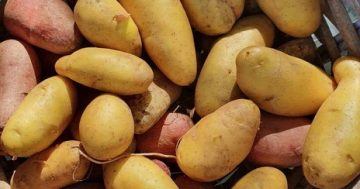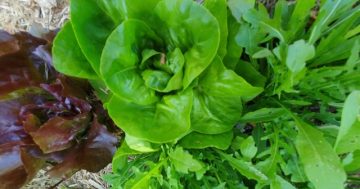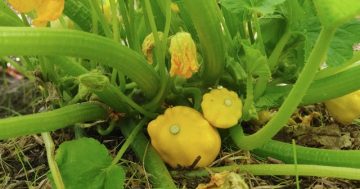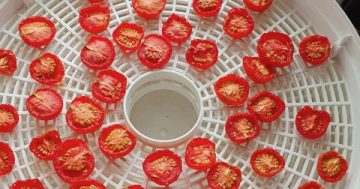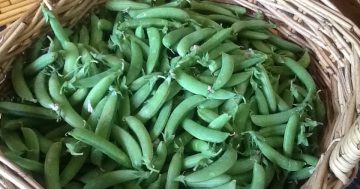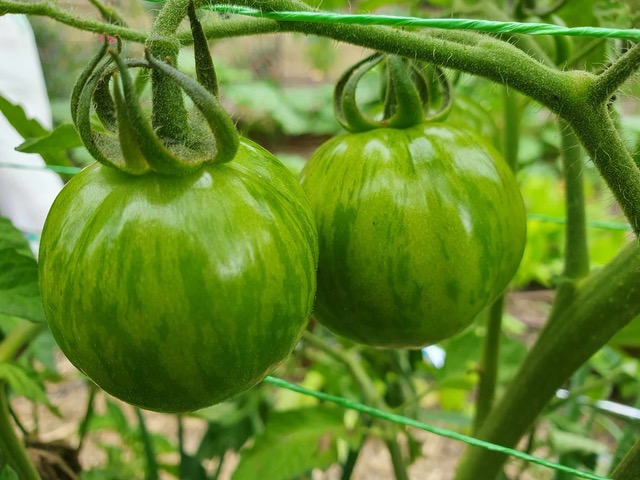
Ripening tomatoes are benefitting from the hot weather. Photo: Supplied.
It’s mid-summer and instead of the El Niño hot, dry weather we were worried about, it’s looking more like January in the ACT and Southern Tablelands will be warm and probably stormy.
Not only do we need to protect some vegetables from very hot days but also heavy rain: have shade cloth at the ready for tender salad vegetables such as lettuce and young greens.
Tap some stakes into the garden bed edges or your pots and drape the shade cloth over, giving relief from hot weather and heavy rain.
While it’s likely we’ll receive average summer rainfall, the weather will be warmer and watering the garden will be on the agenda.
Reserve watering in summer until the cool of the evening. Many garden books caution against watering at night because of the risk of bad bacteria and viruses.
Such advice comes from the Northern Hemisphere and isn’t relevant for our warm, drier summers with moderate humidity. Evening watering gives moisture time to penetrate the soil via osmosis, spreading out and down into the soil for plants to use in the morning.
Our tomatoes, eggplants, chilli, melons and corn love a bit of hot sunny weather but need lots of water to truly thrive. An efficient drip irrigation system is essential to save water while satisfying the thirst of these vegetables and fruits. We’ve used such a system in our commercial market garden for years.

Investing in food quality irrigation pipes will benefit the vegetable garden. Photo: Supplied.
While there are many on the market to choose from, one that lies on the ground can be run under mulch, and has reinforced trickle holes will work well. The reinforcement ensures dirt and other flotsam won’t clog up the holes.
Laying the irrigation can be a pain, but once down, it’s easily lifted when your beds are prepped for new plantings. If you buy reasonable quality, you’ll use it for years.
Once irrigation is fitted, continue your planting regime. Brussel sprouts as seedlings can go in the ground from now until February.
It is too late to plant seeds. The six to eight weeks for growing from seeds means plants won’t go into the ground until Autumn, and in cold climates, this is too late for the plant to develop a tall, strong frame.
The sprout plant, a relative of the cabbage, uses the summer and early Autumn to produce a frame from which sprouts will grow. The taller the frame, which consists of a long central stalk producing large leaves overhanging the growing sprout, the more sprouts will grow and the bigger your yield.

This is the last window for planting some seedlings. Photo: Supplied.
Other summer vegetable seedlings can still be planted this month. This is the last planting opportunity for sweet corn, squash and pumpkins.
Given the warmer weather predicted into Autumn, it may well be worth trying a January planting of well-developed seedlings of cherry tomato, fingerling eggplant and sweet banana pepper. Don’t try this if you are in Cooma or the Alpine regions.
Other vegetables that can still be planted include cucumbers, beans, carrots, peas, Asian greens, celery and celeriac and members of the brassica family. Kohlrabi is great to plant and can be eaten raw in a slaw salad or cooked.
Preparing your soil for these vegetables is relatively straightforward – use pH-neutral compost, well-composed animal manure and a pelleted complete fertiliser supply nitrogen, phosphorus, and potassium. These are essential and usually supplied in the greatest quantity.
Other macronutrients needed in smaller quantities are calcium, magnesium and sulphur. These are easily depleted in the soil by not replacing organic matter, having insufficient microbial activity, and heavy, continuous cropping. Calcium, magnesium and sulphur are often called secondary micronutrients and are very important to vegetables, especially corn.
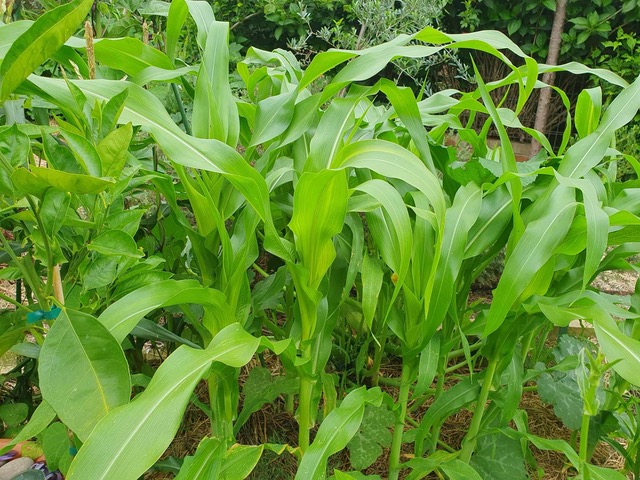
Leafy sweet corn is flourishing in hot, wet weather. Photo: Supplied.
Corn, a wild Mexican grass, was domesticated 10,000 years ago and is the world’s third-largest source of plant-based food.
Organic home-grown sweet corn can have outstanding flavour and texture, especially if secondary nutrients are maintained during the growing period. Keep the pH between 5.5 and 6.5 and add lime plus compost as a side feed during growth.
Distorted young leaves and irregular leaf margins are indicators of low calcium. Magnesium loss shows up as yellowing between the leaf veins, first in older leaves and then in younger ones. Apply a dilution of Epsom salts (1 tsp to 1 litre of water) or sprinkle dolomite around the plant.
The best solution, of course, is to avoid the problem by adding lime/dolomite mix when preparing your soil for planting, but it’s easy to overlook.
Sulphur is another important nutrient, especially for corn. Deficiency shows up as stunting and yellowing in young plants, first in the younger leaves.
Gently digging well-composted animal manure into the soil or as a side dressing can help feed and house essential microbes, making sulphur available to plants.
You know it’s worth the effort once those delicious, juicy, golden yellow cobs, smothered in butter, are served up on your late summer table.
Bronwyn Richards and Helen Lynch run Wynlen House Artisan Village Farm and Learning Centre, a small village organic market garden in Braidwood, NSW. Since 2006 they have grown and sold fresh vegetables, eggs, preserves and garlic and teach others to do the same.
Original Article published by Bronwyn Richards on Riotact.








